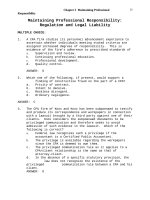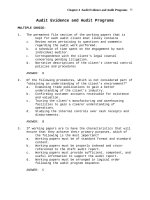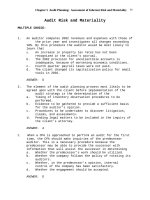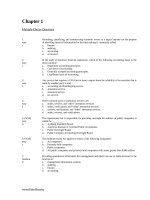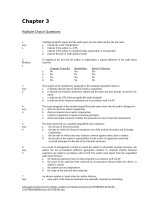Test bank auditing and assurance principles ch16 operational and governmental compliance auditing
Bạn đang xem bản rút gọn của tài liệu. Xem và tải ngay bản đầy đủ của tài liệu tại đây (67.34 KB, 18 trang )
Chapter 16 Operational and Governmental Compliance Auditing 14
Operational and Governmental Compliance Auditing
MULTIPLE CHOICE:
1.
In a broad sense, society benefits from internal auditing
because the internal auditor
a.
Encourages corporate compliance with standards of
public policy.
b.
Promotes the efficient and effective use of resources.
c.
Evaluates financial data against professional
standards.
d.
Ensures that operations respond to the demands of the
marketplace.
ANSWER:
2.
Which of the following factors are essential to an effective
internal auditing organization?
I.
II.
III.
IV.
Operating responsibility
Organizational status
Objectivity
Authority over operations
a.
b.
c.
d.
I and II.
II and III.
III and IV.
I and IV.
ANSWER:
3.
B
B
The primary difference between operational auditing and
financial auditing is that in operational auditing
a.
The auditor is not concerned with whether the audited
activity is generating information in compliance with
financial accounting standards.
b.
The auditor is seeking to help management use resources
in the most effective manner possible.
c.
The auditor starts with the financial statements of an
activity being audited and works backward to the basic
processes involved in producing them.
d.
The auditor can use analytical skills and tools that
are not necessary in financial auditing.
ANSWER:
B
15
4.
Chapter 16 Operational and Governmental Compliance Auditing
The internal audit staff has been asked to conduct an audit
of the purchasing department. Top management feels that
there have been some production bottlenecks recently because
of out-of-stock situations. What is the primary objective
of the auditors in this assignment?
a.
b.
c.
d.
ANSWER:
5.
D
Which of the following would be the most appropriate role
for the internal auditor in the cash budgeting process?
a.
b.
c.
d.
ANSWER:
6.
To appraise the economy with which resources are
employed.
To review the reliability and integrity of financial
and operating information.
To review the means of safeguarding assets and
verifying the existence of such assets.
To ascertain whether results are consistent with
established objectives and whether operations are being
carried out as planned.
Reviewing budget policies and the design and
functioning of the budget process.
Working with the controller to prepare the budget.
Approving the budget before its implementation.
Analyzing monthly budget reports.
A
An internal auditor is performing an audit of the receiving
department to determine if only authorized purchases are
being accepted. Which of the following documents should the
auditor examine?
a.
b.
c.
d.
A bill of lading.
A “blind” (no quantities shown) copy of the purchase
order received directly from the purchasing department.
An invoice.
A note documenting a telephone conversation with a
purchasing agent.
ANSWER:
7.
B
An auditor is attempting to determine whether or not
inventory is excessive. The inventory turnover rate was 4.7
this year as compared to 6.0 the prior year. The average
Chapter 16 Operational and Governmental Compliance Auditing
16
rate for the industry over the past three years was 6.2.
From these facts, the auditor should conclude
a.
b.
c.
d.
ANSWER:
8.
b.
c.
d.
ANSWER:
Vouch payments made on the investment to the
controller’s approval.
Review minutes of board of directors’ meetings for
investment approval.
Compliance test the functioning of the internal
controls over expenditures.
Confirm details of the purchase with the vendor.
B
Which of the following is not usually a part of the
preliminary survey phase of an audit?
a.
b.
c.
d.
ANSWER:
10.
A
Which of the following would be the most appropriate test to
determine if a major investment in a fixed asset was
properly authorized?
a.
9.
An inventory turnover rate this much lower than
“normal” suggests the possibility of excess inventory.
There is definitely an excess inventory problem because
the turnover rate is 1.5 times less than the industry
average.
The turnover rate differences are immaterial and thus
do not indicate a problem.
The possibility of excess inventory is not apparent
from these figures.
Touring operations.
Conducting audit inquiries.
Performing analytical review.
Developing the audit program.
D
An auditor decides to test the effectiveness and efficiency
of the short-term strategy being employed to market product
X. Which of the following would be the most appropriate
audit procedure?
a.
Discuss the effectiveness and the strategy with the
director of marketing.
17
Chapter 16 Operational and Governmental Compliance Auditing
b.
c.
d.
ANSWER:
11.
b.
c.
d.
ANSWER:
Determine the dates of unpaid accounts payable
invoices.
Compare dates of selected purchase orders with those of
purchase requisitions.
Select a block of used purchase order numbers and
account for all numbers in the block.
Discuss processing procedures with operating personnel
and observe actual processing of purchases.
B
In an audit of the transportation function, which of the
following tests is most appropriate to determine if there is
favoritism to individual carriers?
a.
b.
c.
d.
ANSWER:
13.
D
Which of the following would be the most appropriate test to
determine whether purchase orders are being processed on a
timely basis?
a.
12.
Discuss the effectiveness of the strategy with sales
supervisors and individual salespersons.
Compare sales of product X prior to and after
implementation of the short-term marketing strategy.
Evaluate performance goals incorporated into the shortterm strategy, and whether those goals are being met.
Investigate selected demurrage charges to determine if
they were appropriate.
Determine if the selection of carriers is reviewed and
approved by a higher-ranking member of the traffic
department.
Determine whether freight bills have received a postaudit by the transportation department or an outside
specialized freight auditor.
Determine that the amount of freight billed to the
customer on the sales invoice is equal to the amount
actually charged your company by the carrier.
B
In the performance of an audit, audit risk is best defined
as the risk that an internal auditor
a.
Might not select documents that are in error as part of
the examination.
Chapter 16 Operational and Governmental Compliance Auditing
b.
c.
d.
ANSWER:
14.
May not be able to properly evaluate an organization
because of its poor internal accounting controls.
May unknowingly fail to recognize appropriately a
material error or weakness in an examined organization.
May not have the expertise to adequately audit a
specific entity.
C
The role of the internal auditor with respect to a
purchasing department audit is to
a.
b.
c.
d.
ANSWER:
15.
18
Evaluate the adequacy of purchasing policies and
procedures and determine the extent of compliance.
Review and appraise the adequacy of controls over the
creation of all types of company obligations.
Review and appraise the conditions by which notes
payable come into existence and the control exercised
over them.
Establish that the purchasing department is independent
of receiving, inspection, stores, and accounts payable
activities.
A
In examining whether or not an auditee is conforming with
the company’s affirmative action policy, the internal
auditor has found that:
1)
2)
Five percent of the employees are from minority groups.
No one from a minority group has been hired this year.
The most appropriate conclusion the internal auditor should
draw is
a.
b.
c.
d.
ANSWER:
16.
Insufficient evidence exists of compliance with the
affirmative action policy.
The auditee is violating the company’s policy.
The company’s policy is unauditable and hence
unenforceable.
The auditee is complying with the affirmative action
policy.
A
Which of the following is the most important purpose of a
closing conference?
19
Chapter 16 Operational and Governmental Compliance Auditing
a.
b.
c.
d.
ANSWER:
17.
A
The primary audience for the written report issued by the
internal auditor at the completion of an audit should be
a.
b.
c.
d.
ANSWER:
18.
To provide a final quality control review of the
accuracy of findings and reasonableness of conclusions
included in the report.
To inform the board of directors and top management
concerning major problems encountered.
To give auditee managers an advance start on solving
the problems outlined in the report.
To provide the auditor an opportunity to “sell” auditee
management on the benefits of implementing
recommendations.
The external auditors when they intend to rely on the
internal auditor’s work.
Managers outside the area of audit so as to inform them
of what is going on in other areas of the organization.
The audit committee who needs to be kept informed on
the risks to which the organization is exposed.
The management inside or outside the audited area who
can take corrective action.
D
An internal auditor determines that actual procedures differ
from prescribed control procedures. The auditor should
1.
2.
3.
4.
Require operating personnel to conform to prescribed
procedures.
Document the discrepancies and make any appropriate
recommendations to management.
Expand all aspects of the audit to determine other
differences from prescribed procedures.
Modify the audit plan as warranted by the differences
noted.
a.
b.
c.
d.
1
2
1
2
ANSWER:
D
and
and
and
and
3
3
4
4
Chapter 16 Operational and Governmental Compliance Auditing
19.
One of the elements of a standard audit finding is
“criteria.” Which of the following best describes this
element of an audit finding?
a.
b.
c.
d.
ANSWER:
20.
What the auditor found, the status, or condition.
The effect that implementing a recommendation is
expected to achieve.
The standard of performance, or what should be.
The cause or reason why the reported condition
occurred.
C
Follow-up activities by the internal auditor may be
terminated, even though corrective action has not been
taken, when the
a.
b.
c.
d.
ANSWER:
21.
20
Recommendations concern activities not included in the
scope of the original audit program.
Board of directors or management has assumed the risk
of not taking corrective action.
Auditor has not convinced operating personnel of the
soundness of the audit recommendations.
Auditor has no authority or responsibility to prescribe
or direct the corrective action.
B
An internal auditor is preparing a final audit report to
management. There is, however, disagreement between the
auditor and the auditee on one finding which details the
auditee’s violation of corporate purchasing policy. The
auditee believes the purchasing policy is open to
interpretation and that there was no violation. The auditor
believes that the policy is clearly stated and that the
auditee’s actions were a violation. In this circumstance,
the auditor should
a.
b.
c.
d.
Delete the finding from the audit report.
Present only those facts, which support the audit
finding and ignore those which detract from it.
Present both the auditor’s and auditee’s positions in
the report.
Not issue the audit report until the auditor and
auditee agree on all audit findings and
recommendations.
21
Chapter 16 Operational and Governmental Compliance Auditing
ANSWER:
22.
C
A governmental audit may extend beyond an examination
leading to the expression of an opinion on the fairness of
financial presentation to include
Program
results
Yes
Yes
No
Yes
a.
b.
c.
d.
ANSWER:
23.
Compliance
Yes
Yes
Yes
No
Economy &
efficiency
No
Yes
Yes
Yes
B
Chevez is auditing an entity’s compliance with requirements
governing a major federal financial assistance program in
accordance with the Single Audit Act. Chevez detected
noncompliance with requirements that have a material
effect on that program. Chevez’ report on compliance
should express a(an)
a.
b.
c.
d.
ANSWER:
Unqualified opinion with a separate explanatory
paragraph.
Qualified opinion or an adverse opinion.
Adverse opinion or a disclaimer or opinion.
Limited assurance on the items tested.
B
24. A company’s new president meets the director of internal
audit for the first time, and asks the director to briefly
describe his department’s overall responsibility. The
director states that internal audit’s overall responsibility
is to:
a.
b.
c.
d.
Act as an independent appraisal function to review
operations as a service to management by measuring and
evaluating the effectiveness of controls.
Review the means of safeguarding assets and, as
appropriate, verify the existence of such assets.
Ensure compliance with policies, plans, procedures,
laws, and regulations, which could have a significant
impact on operations and reports.
Review the reliability and integrity of financial and
operating information and the means used to identify,
measure, classify, and report such information.
Chapter 16 Operational and Governmental Compliance Auditing
ANSWER:
25.
To determine if corrective action was taken and is
achieving the desired results.
Unless management rejected the recommendation in their
initial response.
Unless the audit schedule does not allow time for
follow-up.
Unless management has accepted the recommendation.
b.
c.
d.
ANSWER:
A
Internal auditing has been a dynamic profession. Which of
the following best describes the scope of internal auditing
as it has developed to date?
a.
b.
c.
d.
ANSWER:
27.
A
According to the Standards, the internal audit director
should ensure follow-up of prior audit findings and
recommendations:
a.
26.
22
Internal auditing involves appraising the economy and
efficiency with which resources are employed.
Internal auditing involves evaluating compliance with
policies, plans, procedures, laws, and regulations.
Internal auditing has evolved to verifying the
existence of assets and reviewing the means of
safeguarding assets.
Internal auditing has evolved to more of an operational
orientation from a strictly financial orientation.
D
You have been selected to develop an internal auditing
department for your company. Your approach would most
likely be to hire:
a.
b.
c.
d.
Internal auditors each of whom possesses all the skills
required to handle all audit assignments.
Inexperienced personnel and train them the way the
company wants them trained
Degreed accountants since most audit work is accounting
related.
Internal auditors who collectively have the knowledge
and skills needed to complete all internal audit
assignments.
23
Chapter 16 Operational and Governmental Compliance Auditing
ANSWER:
28.
Which of the following is the most appropriate method of
reporting disagreement between the auditor and the auditee
concerning audit findings and recommendations?
a.
b.
c.
d.
ANSWER:
29.
State the auditor’s position because the report is
designed to provide the auditor’s independent view.
State the auditee’s position because management is
ultimately responsible for the activities reported.
State both positions and identify the reasons for the
disagreement.
State neither position. If the disagreement is
ultimately resolved, there will be no reason to report
the previous disagreement. If the disagreement is
never resolved, the disagreement should not be
reported, because there is no mechanism to resolve it.
C
A charter is being drafted for a newly formed internal
auditing department. Which of the following best describes
the appropriate organizational status that should be
incorporated into the charter?
a.
b.
c.
d.
ANSWER:
30.
D
The director of internal auditing should report to the
chief executive officer but have access to the board of
directors.
The director of internal auditing should be a member of
the audit committee of the board of directors.
The director of internal auditing should be a staff
officer reporting to the chief financial officer.
The director of internal auditing should report to an
administrative vice president.
A
A primary concern of an operational audit of the family
welfare department of a governmental unit would be
a.
b.
c.
d.
Determining that proper measures of performance are
used.
Generating an adequate return on investment.
Adhering to Generally Accepted Accounting Principles.
Ensuring that persons with direct client contact have
at least a bachelor’s degree.
Chapter 16 Operational and Governmental Compliance Auditing
ANSWER:
31.
b.
c.
d.
ANSWER:
The director reports directly to an independent audit
committee of the board of directors.
The director of internal auditing is not assigned any
operational responsibilities.
A director of internal auditing may not be appointed or
approved without concurrence of the board of directors.
The director’s annual bonuses are based on dollar
recoveries or recommended future savings as a result of
audits.
D
The president wants to know whether the purchasing function
is properly meeting its charge to: “purchase the right
material at the right time in the right quantities.” Which
of the following types of audits addresses the president’s
request?
a.
b.
c.
d.
ANSWER:
33.
A
Which of the following could be an organization factor that
might adversely affect the ethical behavior of the director
of internal auditing?
a.
32.
24
A financial audit of the purchasing department.
An operational audit of the purchasing department.
A compliance audit of the purchasing function.
A full-scope audit of the manufacturing operation.
B
Which of the following audit techniques would be most
persuasive in determining that significant inventory values
on the books of a comp[any being acquired are correctly
stated?
a.
b.
c.
d.
Obtain a management representation letter stating that
inventory values are correctly stated.
Flowchart the inventory and warehousing cycle and form
an opinion based on the quality of internal controls.
Conduct a physical inventory and bring in an
independent expert if necessary to value inventory
items.
Interview purchasing and materials control personnel to
ascertain the quality of internal controls over
inventory.
25
Chapter 16 Operational and Governmental Compliance Auditing
ANSWER:
34.
After an audit report with adverse findings has been
communicated to appropriate auditee personnel, proper action
is to:
a.
b.
c.
d.
ANSWER:
35.
c.
d.
ANSWER:
A
Has no role; follow-up is management’s responsibility.
Should be charged with responsibility for implementing
audit recommendations.
Should follow up to ascertain that appropriate action
is taken on audit recommendations.
Should request that independent auditors follow up on
audit recommendations.
C
The purpose of governmental effectiveness or program
results auditing is to determine if the desired results
of a program are being achieved. The first step in
conducting such an audit should be to:
a.
b.
c.
d.
ANSWER:
37.
Schedule a follow-up review.
Implement corrective action indicated by the findings.
Examine further the data supporting the findings.
Assemble new data to support the findings.
Recommendations in audit reports may, or may not,. Actually
be implemented. Which of the following best describes
internal auditing’s role in follow-up on audit
recommendations?
Internal auditing:
a.
b.
36.
C
Evaluate the system used to measure results.
Determine the time frame to be audited.
Collect quantifiable data on the program’s success or
failure.
Identify the legislative intent of the program being
audited.
D
An operational audit resulted in a finding regarding
efficiency of operations. Select the best approach to gain
the auditee’s cooperation in this situation.
Chapter 16 Operational and Governmental Compliance Auditing
a.
b.
c.
d.
ANSWER:
38.
Allow the auditee to participate in development of
recommendations for improvement.
Emphasize the personal responsibility of the auditee
management.
Document the adverse finding with a complete list of
all operational deficiencies.
Submit a draft copy of the final report to higher-level
management.
A
A major difference between operational auditing and
financial auditing is
a.
b.
c.
d.
ANSWER:
39.
26
Operational auditing focuses on activities rather than
financial statement assertions.
Operational auditing extends beyond the entity to
analysis of industry and economic data.
Unlike financial auditing, operational auditing does
not generally culminate in a formal audit report.
Operational auditing is narrower than financial
auditing in its breadth of coverage.
A
In conducting an operational audit, the following steps are
generally recommended:
A.
B.
C.
D.
Develop the audit program
Perform the audit
Identify audit objectives
Evaluate the findings and develop conclusions and
recommendations
E.
Establish evaluation criteria
F.
Report findings and recommendations
G.
Conduct a preliminary survey of the activity
H.
Appraise the efficiency and effectiveness of the
activity
The proper sequence for applying the above steps is:
a.
b.
c.
d.
ANSWER:
D,H,B,F,E,G,A,C
C,E,G,A,H,B,D,F
E,C,A,G,D,H,B,F
C,E,G,A,B,H,D,F
D
27
40.
Chapter 16 Operational and Governmental Compliance Auditing
A major part of an operational audit involves appraising
the efficiency and effectiveness of the activity or unit
being audited. Efficiency and effectiveness appraisal
include all but the following steps:
a.
b.
c.
d.
ANSWER:
41.
C
The primary difference between an operational audit report
and an independent financial audit report is
a.
b.
c.
d.
ANSWER:
42.
Assessing the goal setting process.
Determining the extent to which goals are being
achieved and the degree of coal congruence.
Assessing the financial stability of the unit.
Appraising the effectiveness of resource utilization
within the unit or activity.
The operational audit report makes no mention of
internal control.
The operational audit report is not constrained to a
single standard reporting format.
The operational audit report stresses consistency among
accounting periods.
Unlike the independent auditor, the internal auditor
generally does not discuss the audit findings and the
nature of the audit report with the auditee.
B
Which of the following is not a source of responsibility
for an independent auditor conducting a governmental
compliance audit?
a.
b.
c.
d.
ANSWER:
Governmental auditing standards as set forth in the
General Accounting Office’s “yellow book.”
Standards for the Professional Practice of Internal
Auditing.
Generally Accepted Auditing Standards as promulgated by
the Auditing Standards Board of the AICPA.
Federal Single Audit Act of 1984 (as amended in 1996).
B
COMPLETION:
43.
Management auditing concentrates more on ____________ than
efficiency.
Chapter 16 Operational and Governmental Compliance Auditing
ANSWER:
44.
CAUSE EFFECT
When auditing state and local governmental entities that
are recipients of federal financial assistance, auditors
must, in addition to generally accepted auditing standards,
comply with governmental auditing standards, as defined in
the GAO’s _________ _________.
ANSWER:
50.
AUDIT PROGRAM
In drafting an operational audit report, the difference
between actual and expected conditions should be presented
as to _______ and _______.
ANSWER:
49.
EVALUATION CRITERIA
The __________ __________ consists of those procedures
necessary to satisfy the audit objectives and produce
sufficient and competent evidence to corroborate or refute
the auditor’s preliminary findings.
ANSWER:
48.
RISK-BASED
In conducting an operational audit, identification of
___________ __________ is necessary if the auditor is to
ultimately determine the cause of discovered inefficiencies.
ANSWER:
47.
INPUT OUTPUT
Until recently, operational auditing performed recurring
efficiency and effectiveness audits on different functions
or units in a company. The emphasis has now begun to shift
away from recurring audits to focus more on management’s
special problems. This latter approach is referred to as
________- __________ operational auditing.
ANSWER:
46.
EFFECTIVENESS
Efficiency is __________ oriented, whereas effectiveness is
__________ oriented.
ANSWER:
45.
28
YELLOW BOOK
In addition to GAAS and “yellow book” standards, an auditee
29
Chapter 16 Operational and Governmental Compliance Auditing
that receives $300,000 or more in federal financial
assistance in a single fiscal year, must be audited in
accordance with the ________ ________ _______ __ ____.
ANSWER:
SINGLE AUDIT ACT OF 1984
MATCHING:
51.
A.
B.
C.
D.
E.
F.
G.
H.
I.
J.
K.
L.
M.
Select the term that best fits the listed definition.
Circular A-133
Effectiveness
Efficiency
Evaluation criteria
Yellow book
Risk-based operational auditing
Percentage-of-coverage rule
Operational auditing
Management auditing
General Accounting Office
Foreign Corrupt Practices Act of 1977
Single Audit Act of 1984 (as amended in 1996)
Governmental compliance auditing
____1.
A subset of internal auditing that reviews an entity’s
activities for efficiency and effectiveness.
____2.
A subset of operational auditing that attempts to
measure the effectiveness with which an organizational
unit is administered.
____3.
May be viewed as an input measure.
____4.
May be viewed as an output measure.
____5.
Requires companies to develop and implement internal
controls that permit preparation of financial
statements in accordance with GAAP and to maintain
accountability over assets.
____6.
An audit approach that focuses on management’s special
problems and means for solving them.
____7.
Define the process or activity being audited.
Chapter 16 Operational and Governmental Compliance Auditing
30
____8.
Auditing that concentrates on testing and reporting on
conformity with laws and regulations relating to
recipients of federal financial assistance.
____9.
A GAO document that sets forth governmental auditing
standards.
____10.
A federal law that establishes audit requirements for
state and local governmental bodies and other not-forprofit entities receiving federal financial assistance.
____11.
Requires that at least 50% of federal expenditures be
encompassed by the independent audit.
____12.
The document that interprets and explains the major
provisions of the Single Audit Act of 1984 (as amended
in 1996).
SOLUTION:
1.
2.
3.
4.
5.
6.
7.
8.
9.
10.
11.
12.
H
I
C
B
K
F
D
M
E
L
G
A
31
Chapter 16 Operational and Governmental Compliance Auditing
